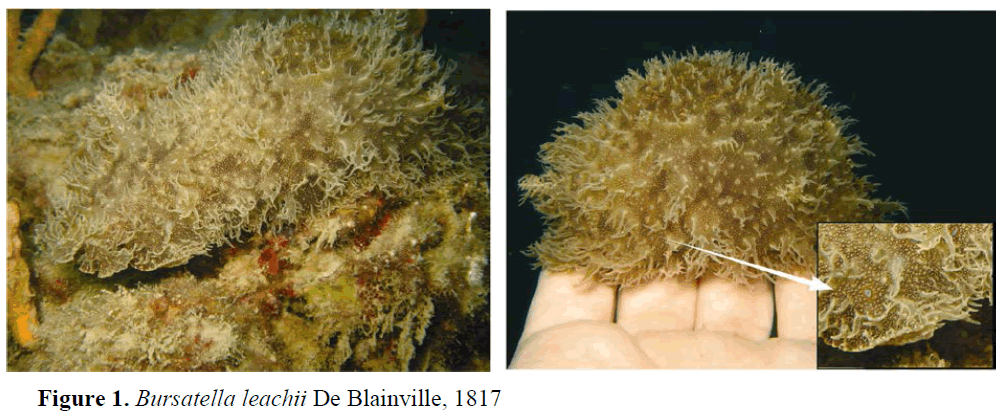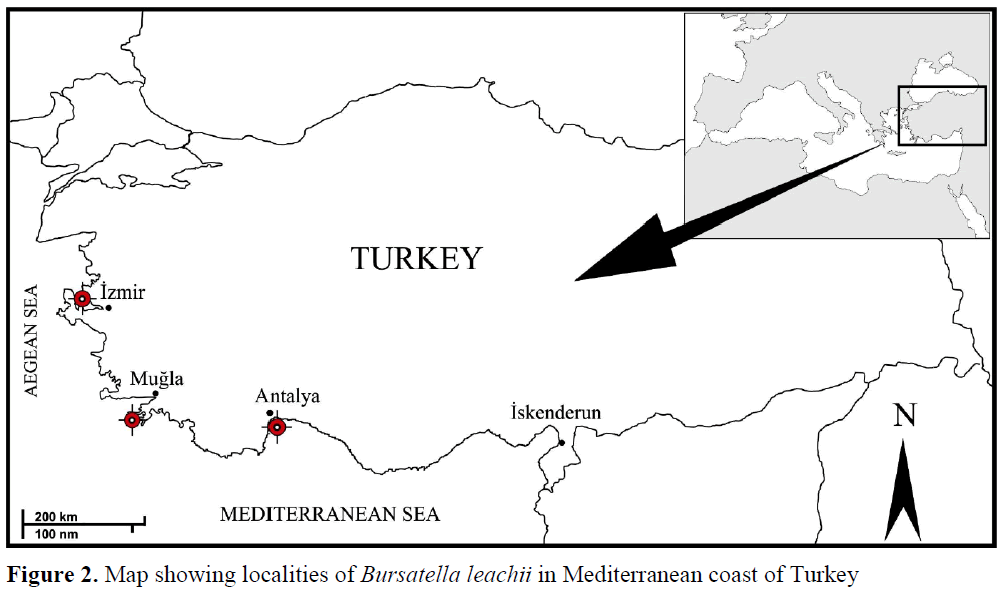Keywords
Bursatella leachii, Aplysiidae, Distribution, Turkey, Mediterranean Sea
Introduction
The Turkish Levantine and Aegean Sea coast (southern coast of Turkey), where are deeply af-fected region by the migration of alien species in the Levantine Sea, and a great part of the studies carried out in the region are focused on alien spe-cies. According to Çinar et al. (2011), among the 400 alien species known to be distributed along the Turkish coasts, 105 species are molluscs, of which 98 species are distributed on the Turkish Levantine coast.
Although there are many studies studies on the molluscan fauna distributed along the Turkish Levantine coast (Swennen (1961), Falchi (1974), Blöcher (1983), Lindner (1987), Buzzurro and Greppi (1994, 1996), Buzzurro et al. (1995), Tringali and Villa (1990), Yoke? and Rudman (2004), Öztürk and Aartsen (2006), Öztürk and Can (2006) and Özvarol et al. (2010)), there are only few records related to molluscan fauna in Izmir Bay and Aegean Sea (Yokes and Rudman, 2004; Öztürk & Poutiers, 2005; Ç?nar et al., 2006).
In the present pap er, the distribution of im-migrant Bursatella leachii Blainville, 1817 was examined in Turkish Mediterranean shores (Turkish Levantine and Aegean coasts).
Materials and Methods
A single specimen of B. leachii was observed during SCUBA diving activity in Konyaalt? beach at a depth of 25 meters, 29 September 2012, in the Mediterranean coasts of Turkey (Figure 1). It is kept alive in a sample box and transferred laboratories of the Fisheries Faculty of Akdeniz University. After identification it is deposited at the Fish Museum (Sample ID: 12).

Figure 1: Bursatella leachii De Blainville, 1817.
In Turkish coasts, this species was recorded firstly by Swennen (1961). Recently, some spec-imens of B. leachii were reported from Datça-Bozburun (Mu?la) by Umut Tural (2004), from ?nciralt? coastline by Kazak and Cava? (2007) and Urla fishing Port ?zmir Bay by Tanr?kul and Akyol (2010). Last report is provided by present study in 2012 from the Gulf of Antalya (Figure 2).

Figure 2: Map showing localities of Bursatella leachii in Mediterranean coast of Turkey.
Short description: Body 8 cm. Two pair of tentacules on the broad and short head. Short and triangular tail with white bands. Body covers dif-ferent shadows of brown color. Blue colored eye-spots and white branched papillae scattered over the brown body.
Results
The ragged sea hare, Bursatella leachii De Blainville, 1817, is a medium to large-sized (usu-ally from 50 to 100 mm, up to 150 mm) benthic opisthobranch mollusc (Voss, 1980; CIESM, 2002). It is a circum-tropical species found nearly worldwide in warm temperate to tropical marine environments and it is common in intertidal and subtidal sheltered bay and estuarine habitats with sand or muddy bottoms, and are a frequently en-countered component of tropical and subtropical sea grass and mangrove communities (Lowe and Turner, 1976).
According to CIESM exotic atlas, mode of in-troduction is either by ships from the tropical At-lantic or via the Suez Canal (i.e. Lessepsian), and in the Mediterranean, B. leachii is very common from the eastern Mediterranean Sea to the Italian coasts in the western Basin, only known from an area between Taranto Sea, Sicily, Naples, Sardin-ia, Malta and Tunisia (CIESM, 2002; Zakhama-Sraieb et al., 2009; Gravili et al., 2010). Despala-tovic et al. (2008) reported that this species was occasionally observed in the area of the middle Adriatic (around Split and Hvar Island) in the last two decades.
Bursatella leachii, also known as immigrant the ragged sea hare, is established in Turkish Aegean Sea (Tural, 2004; Ç?nar et al., 2005, Kazak and Cava?, 2007), This species was recently reported several times from ?zmir Bay and Datça Bozburun (Mu?la).
Conclusion
It is expected that its distribution may expand along whole Turkish Mediterranean coasts.
46
References
- Blöcher, M., (1983). A dead specimen of Palmadusta gracilis (Gaskoin, 1849) found in the Mediterranean, La Conchiglia, 10: 166-167
- nÇ?nar, M.E., Bileceno?lu, M., Öztürk, B., Katagan, T., Aysel, V., (2005). Alien species on coasts of Turkey, Mediterranean Marine Science, 6(2): 119-146. doi: 10.12681/mms.187
- nÇ?nar, M.E., Katagan, T.Ö.B., Egemen, Ö., Ergen, Z., Kocata?, A., Önen, M., K?rk?m, F., Bak?r, K., Kurt, G., Da?l?, E., Kaymakç?, A., Aç?k, S., Do?an, A., Özcan, T., (2006). Temporal changes of soft bottom zoobenthic communities in and around Alsancak Harbor (Izmir Bay, Aegean Sea), with special attention to the autoecology of exotic species, Marine Ecology, 27: 229-246. doi: 10.1111/j.1439-0485.2006.00102.x
- nÇinar, M.E., Bileceno?lu, M., Öztürk, B., Kata?an, T., Yoke?, M.B., Aysel, V., Da?li, E., Açik, S., Özcan, T., Erdo?an, H., (2011). An updated review of alien species on the coasts of Turkey, Mediterranean Marine Science, 12(1): 21-41
- nKazak, M., Cava?, L., (2007). On the occurrence of Bursatella leachii de Blainville, 1817 in Izmir Bay, Turkey, Mediterranean Marine Science, 8(2): 87-90. doi: 10.12681/mms.156
- nLindner, G., (1987). Interessante Schneckenfunde an der Südtürkischen Mittelmeerküste (Reisemitbringsel der Familie SCHMIDT, Feldkirchen), Club Conchylia Informationen, 19: 32-43
- nÖztürk, B., Can, A., (2006). Indo-Pacific gastropod species in the Levantine and Aegean Seas, Aquatic Invasions, 1(3): 124-129. doi: 10.3391/ai.2006.1.3.4
- nÖztürk, B., Do?an, A., Bitlis, B., Önen, M., (2008). Türkiye Denizleri’ nde Da??l?m Gösteren Bela, Fehria ve Mangelia (Gastropoda:Conidae) Türlerinin Taksonomik ve Ekolojik Özellikleri, C. Çevik & D. Ergüden (Ed.), 2nd National Malacology Congress, Adana: Turkey: 22-60
- nSwennen, C., (1961). On a collection of Opisthobranchia from Turkey, Zoologische Mededelingen, 38: 41-75
- nTringali, L., Villa, R., (1990). Rinvenimenti malacologici dalle coste Turche (Gastropoda, Polyplacophora, Bivalvia), Notizario CISMA, 11: 33-41
- nVoss, G.L., (1980). Seashore Life of Florida and the Caribbean. Dover Publications, Inc., New York, 199 p








